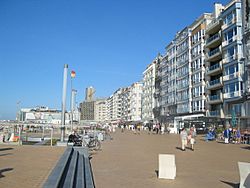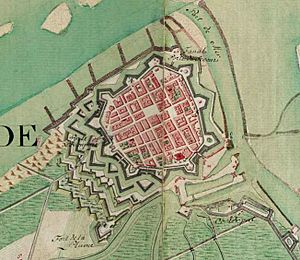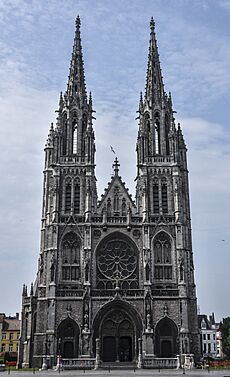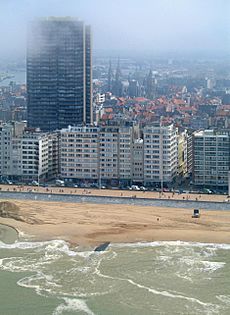Ostend facts for kids
Quick facts for kids
Ostend
Ostende (French)
|
|||
|---|---|---|---|

Promenade at Ostend seaside
|
|||
|
|||
| Country | Belgium | ||
| Community | Flemish Community | ||
| Region | Flemish Region | ||
| Province | West Flanders | ||
| Arrondissement | Ostend | ||
| Area | |||
| • Total | 37.72 km2 (14.56 sq mi) | ||
| Population
(2018-01-01)Lua error in Module:Wd at line 1575: attempt to index field 'wikibase' (a nil value).
|
|||
| • Total | Lua error in Module:Wd at line 1,575: attempt to index field 'wikibase' (a nil value). | ||
| Postal codes |
8400
|
||
| Area codes | 059 | ||
Ostend (pronounced ost-END) is a lively coastal city in Belgium. It's located in the West Flanders province, right on the North Sea. Ostend is the biggest city on the Belgian coast and includes smaller areas like Mariakerke and Raversijde. It's a popular spot for holidays and has a rich history.
Contents
History of Ostend
Early Days and Growth
Long ago, in the Early Middle Ages, Ostend was just a tiny village. Its name, "Oostende," means "east end" in Dutch. It was built on the eastern tip of an island. The people living there mainly earned their living by fishing.
Around the year 1265, Ostend became a "town." This meant its people could hold markets and build a market hall. The sea was always a threat, so in 1395, the villagers decided to move. They built a new Ostend further inland, protected by strong dikes.
Battles and Trade in Ostend
Ostend's location on the North Sea was great for its harbor. But it also caused many problems. The town was often attacked and destroyed by armies. For example, during the Eighty Years' War, there was a very long and difficult battle called the Siege of Ostend (1601–1604). Many lives were lost on both sides.
Later, Ostend became an important harbor. In 1722, the Dutch blocked the entrance to the big harbor of Antwerp. This made Ostend even more important because it offered another way to the sea. The Austrian Emperor Charles VI even allowed Ostend to trade directly with Africa and the Far East. This led to the creation of the Oostendse Compagnie (Ostend trade company). However, other countries like the Netherlands and Britain didn't want competition. So, the company had to stop its activities in 1727.
Modern Ostend: Royal Visits and World Wars
In 1826, a big explosion happened in Ostend, causing a lot of damage and injuries. But the city kept growing. Its harbor improved, and in 1838, a railway line connected Ostend to Brussels. In 1846, the first ferry sailed from Ostend to Dover, England, making it a key travel point.
Belgian kings Leopold I and Leopold II loved to spend their holidays in Ostend. They helped build grand buildings like the Hippodrome Wellington (a horse racing track) and the Royal Galleries of Ostend. Soon, Ostend became known as "the queen of the Belgian sea-side resorts."
During World War I and World War II, German forces occupied Ostend. They used its port for their ships. This led to a lot of destruction in the city. After the wars, many old buildings were replaced with newer, modern ones.
Ostend Today
Today, Ostend is a popular place for festivals and events. The "Winter in the Park" festival attracts many visitors. In December, the city hosts one of Europe's largest Christmas markets. It features vendors, food, ice skating, and a fun light-show tunnel.
Things to See in Ostend
Ostend is famous for its beautiful seaside promenade, which includes the Royal Galleries of Ostend. It also has a long pier and lovely sandy beaches. Many people visit Ostend for a day trip, especially in July and August. They often head to the Klein Strand (Small Beach) near the pier. Locals usually go to the larger Groot Strand (Big Beach).
Near the beach, you can visit the Atlantic Wall Open Air Museum in Raversijde. This museum shows a well-preserved part of the old fortified Atlantic Wall. You can walk through the streets around Het Vissersplein (Fisherman's Square). This car-free area has many cafes where you can relax. Near the port, you'll find small fish shops and can watch ferries arrive and depart.
Other cool places to visit include:
- The Casino and Fort Napoleon, Ostend
- Oostende railway station
- The Mercator, an old training sailing ship you can explore
- Hippodrome Wellington, for horse racing
- St Petrus and St Paulus Church, Ostend (Sint-Petrus-en-Pauluskerk), a stunning church built in a Neo Gothic style
- King Leopold II statue
- The Synagogue of Ostend
Museums in Ostend
If you like art, you can visit the James Ensor museum. It's in the house where the famous artist lived for many years.
The Mu.Zee is another great museum. It shows modern art from the 1830s to today. You can see works by well-known local painters like James Ensor, Leon Spilliaert, and Constant Permeke. It also features art from the COBRA movement.
Climate in Ostend
Ostend has a mild climate because it's close to the North Sea. This means summers are usually cooler than in places further inland. It rarely gets freezing cold. Ostend's climate is known as a "marine west coast climate."
| Climate data for Ostend (1991–2020 normals, extremes since 1973) | |||||||||||||
|---|---|---|---|---|---|---|---|---|---|---|---|---|---|
| Month | Jan | Feb | Mar | Apr | May | Jun | Jul | Aug | Sep | Oct | Nov | Dec | Year |
| Record high °C (°F) | 14.0 (57.2) |
17.8 (64.0) |
23.7 (74.7) |
25.6 (78.1) |
31.8 (89.2) |
32.9 (91.2) |
37.8 (100.0) |
35.6 (96.1) |
32.1 (89.8) |
26.9 (80.4) |
19.2 (66.6) |
15.0 (59.0) |
37.8 (100.0) |
| Mean maximum °C (°F) | — | — | — | — | — | — | — | — | — | 15.1 (59.2) |
— | — | 15.1 (59.2) |
| Mean daily maximum °C (°F) | 6.8 (44.2) |
7.5 (45.5) |
10.2 (50.4) |
13.5 (56.3) |
16.6 (61.9) |
19.3 (66.7) |
21.5 (70.7) |
21.9 (71.4) |
19.3 (66.7) |
15.1 (59.2) |
10.5 (50.9) |
7.3 (45.1) |
14.1 (57.4) |
| Daily mean °C (°F) | 4.1 (39.4) |
4.4 (39.9) |
6.5 (43.7) |
9.2 (48.6) |
12.6 (54.7) |
15.4 (59.7) |
17.4 (63.3) |
17.6 (63.7) |
15.0 (59.0) |
11.4 (52.5) |
7.6 (45.7) |
4.8 (40.6) |
10.5 (50.9) |
| Mean daily minimum °C (°F) | 1.4 (34.5) |
1.3 (34.3) |
2.9 (37.2) |
4.8 (40.6) |
8.6 (47.5) |
11.5 (52.7) |
13.4 (56.1) |
13.2 (55.8) |
10.7 (51.3) |
7.8 (46.0) |
4.7 (40.5) |
2.2 (36.0) |
6.9 (44.4) |
| Record low °C (°F) | −15.0 (5.0) |
−12.3 (9.9) |
−11.3 (11.7) |
−4.9 (23.2) |
−1.0 (30.2) |
2.6 (36.7) |
3.3 (37.9) |
5.0 (41.0) |
0.6 (33.1) |
−5.4 (22.3) |
−7.4 (18.7) |
−11.0 (12.2) |
−15.0 (5.0) |
| Average precipitation mm (inches) | 62.1 (2.44) |
56.2 (2.21) |
47.3 (1.86) |
40.6 (1.60) |
53.9 (2.12) |
62.5 (2.46) |
67.6 (2.66) |
83.6 (3.29) |
74.0 (2.91) |
79.7 (3.14) |
87.6 (3.45) |
85.8 (3.38) |
800.9 (31.52) |
| Average precipitation days (≥ 1 mm) | 11.9 | 10.5 | 9.5 | 8.3 | 9.0 | 9.0 | 9.3 | 9.7 | 9.8 | 12.1 | 13.5 | 13.7 | 126.3 |
| Mean monthly sunshine hours | 66 | 86 | 144 | 206 | 230 | 232 | 238 | 223 | 171 | 121 | 68 | 54 | 1,839 |
| Source 1: Royal Meteorological Institute | |||||||||||||
| Source 2: Infoclimat | |||||||||||||
Getting Around Ostend
Ostend has its own airport, Ostend–Bruges International Airport, which is about 5 kilometers (3 miles) away. It mainly handles cargo flights but also has passenger flights to holiday spots in Southern Europe and Turkey.
The Ostend railway station is a big transport hub. You can catch frequent trains to other Belgian cities like Brugge, Gent, Brussels, and Liège. The Coast Tram also connects Ostend to towns all along the coast, from De Panne in the south to Knokke-Heist in the north.
In the past, ferries used to travel from Ostend to Dover and Ramsgate in England. However, these services stopped in 2013.
Ostend Photo Gallery
Sister Cities
Ostend is connected with other cities around the world. These are called "sister cities" or "twin towns."
Famous People from Ostend
Many notable people have connections to Ostend, including:
- Lilian Baels, a princess
- Auguste Marie Francois Beernaert, a former prime minister and Nobel Peace Prize winner
- James Ensor, a famous painter
- Marvin Gaye, a well-known musician
- Arno Hintjens, lead singer of TC Matic
- Marie-José of Belgium, a princess who became the last queen of Italy
- Divock Origi, a footballer
- Constant Permeke, an expressionist painter
- Raoul Servais, a filmmaker
- Leon Spilliaert, a painter
- Robert Van De Walle, a judoka
- Julie Vanloo, a professional basketball player
Sports Teams in Ostend
Ostend has several sports clubs:
- BC Oostende (basketball)
- Hermes Volley Oostende (volleyball)
- K.V. Oostende (football)
- Wellington Golf Oostende (golf)
See also
 In Spanish: Ostende para niños
In Spanish: Ostende para niños


















